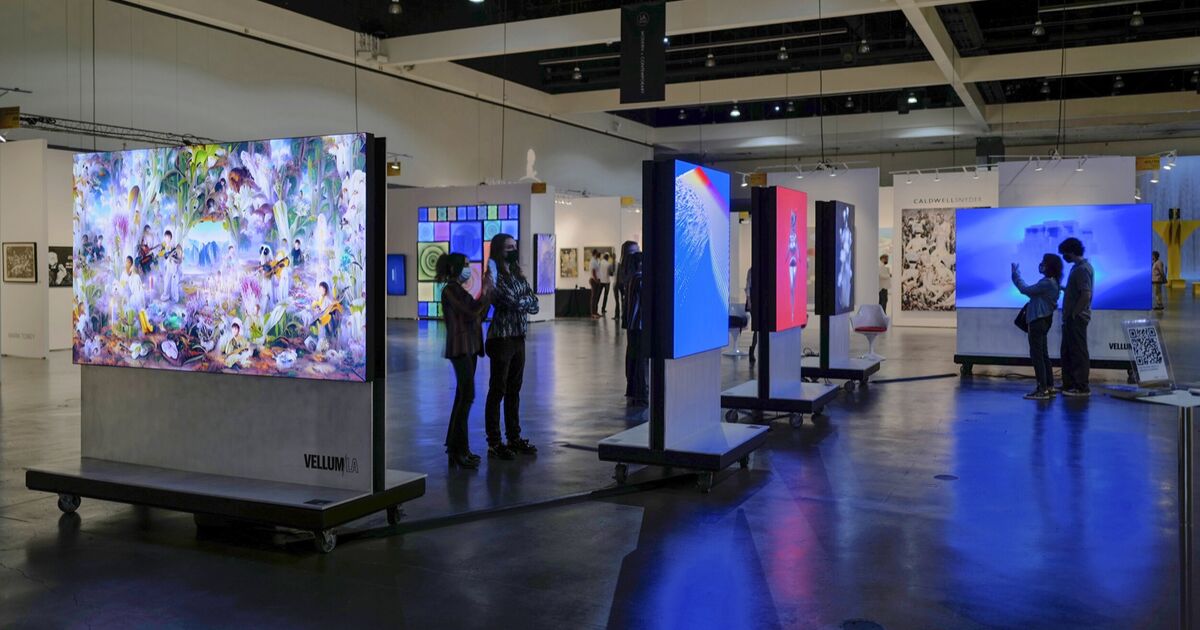Pilar Zeta, detail of Hall of Visions Aorist NFT, 2021. © Pilar Zeta. Courtesy of the artist.
NFTs took off during the COVID-19 pandemic largely because they could be experienced on digital-only platforms, and because physical presence was not essential in the acquisition or presentation of an NFT. Instead of traditional gallery settings, collectors and viewers could see works in metaverse spaces like Decentraland, a virtual world users can explore via avatars on their phone, laptop, or VR headset.
However, the fervent glee over the return to in-person activities following the pandemic has demonstrated that physical exhibitions remain essential components to the presentation of all forms of art. NFTs are no exception to this. But many collectors are unfamiliar with how to actually display these virtual works in their real-world homes, especially as many of us continue to remain inexperienced in navigating the technical specifications of our screens.
Installation view of “Sea Change,” at Vellum LA, 2021. Courtesy of Vellum LA, LA SuperRare, NY.
Take a mainstream experience that occurred in 2019. The widely watched third episode of the final season of Game of Thrones, “The Long Night,” was deemed unwatchable by viewers. There were several reasons for this: It was a dimly lit episode shot at night; it was high-resolution; and it was a compressed file that exceeded the bandwidth that most home screens were able to process quickly. The optimal viewing conditions required a hi-definition monitor with lots of memory space—equipment not owned by the millions who watched the episode on their laptop, tablets, or phones even!
NFTs that lack a physical component are no less high-maintenance, demanding some added technological investment in a high-quality monitor in order to be fully appreciated.
Sinziana Velicescu, director and curator of Los Angeles–based NFT gallery, Vellum LA, pointed out that some of the issues with displaying NFTs regard resolution and aspect ratios. “Some collectors are insistent on displaying all of their artworks on one screen regardless of aspect ratio, but you wouldn’t buy a horizontal frame to display a vertical photograph or painting, or vice versa,” she wrote. “The other most important consideration is to make sure you know the resolution and file format of the work you’re collecting and are able to obtain the high resolution artwork with as little compression as possible. High resolution or master files are typically pinned to an online cloud service by the artist.”
Petra Cortwright, still of PC_Flower_Vase 001, 2021. © Petra Cortwright. Courtesy of SuperRare Gallery, NY.
Petra Cortwright, still of PC_Flower_Vase 001, 2021. © Petra Cortwright. Courtesy of SuperRare Gallery, NY.
Many of the artists working in NFTs are already digital experts and take great care to calibrate the color, light, and vividness of their digital imagery to screens that can properly display them. Pilar Zeta’s work, for example, is an incredible reminder as to why an added investment should be taken when choosing to display these works in one’s home. Zeta’s colorful physical installations of sculptures are inspired by postmodernist furniture and design of the 1980s. These sculptures and Zeta’s immersive NFT videos of them transform the environments they are presented in. There is also the work of Petra Cortwright, whose kaleidoscopic digital paintings are the result of over a decade of experience in the digital arts. As is the work of Morehshin Allahyari, whose NFTs transform and mutate onscreen as they are exhibited over time and require extended displays in order to fully experience them.
With compelling NFT works like this in mind, collectors might want to invest in alternatives to the screens they already own when displaying them. One option Velicescu suggested is Luma Canvas, a museum-quality LED display that Vellum LA uses in its gallery. “LED is different from LCD technology because it can provide a more vibrant image and impactful experience,” she wrote. “We also like that the surface of the displays is matte and that all of the hardware is embedded inside of the canvas.”
Installation view of “Artists who Code,” at Vellum LA, 2021. Courtesy of Vellum LA, LA;
An Rong, senior curator at New York–based SuperRare Gallery, strongly recommended the Samsung QLED monitor along with some other suggestions. “There are also many display startups targeting specifically the NFT collectors, such as Infinite Objects, Lago, Meural, Atomic Form, which only allow owners of the NFTs to display them. That way it acts as another layer of authentication for the NFTs,” she wrote. Rong also expressed that NFTs may work best in their natural environment of the metaverse and listed Oncyber, Spatial, and Cryptovoxels as spaces with NFT art that can be viewed through one’s avatars.
New developments in technology will always attract artists. And while artists might embrace the rapid changes that entails, collectors may be less aware of the specifics of those technological developments and how they affect a work of art. NFT-centered galleries like SuperRare and Vellum LA provide invaluable insight into how to display NFTs because of their close relationship with artists. More NFT shows will give collectors a sense of how to display and honor the uniqueness of this growing medium in both its virtual and physical home.


